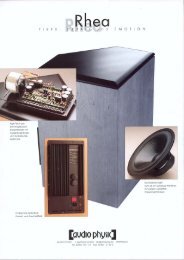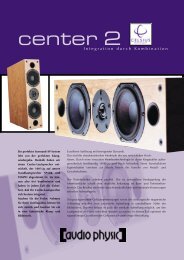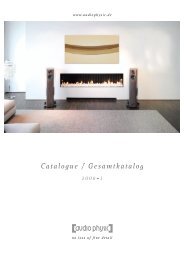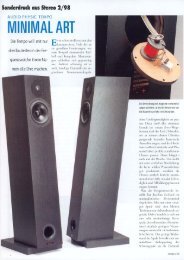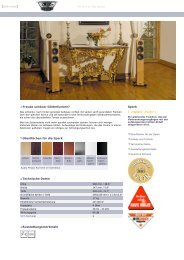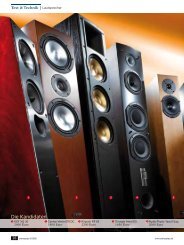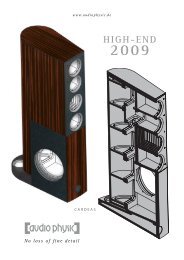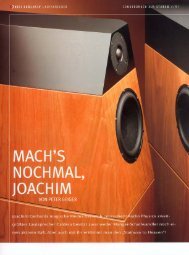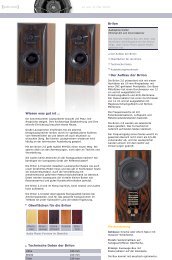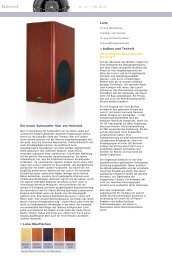Audio Physic Scorpio Loudspeakers
Audio Physic Scorpio Loudspeakers
Audio Physic Scorpio Loudspeakers
You also want an ePaper? Increase the reach of your titles
YUMPU automatically turns print PDFs into web optimized ePapers that Google loves.
Bitten By A New Tradition<br />
The <strong>Scorpio</strong> is the newest <strong>Audio</strong> <strong>Physic</strong> loudspeaker and,<br />
at $6495, sits at a rather tricky price point. Anyone who<br />
would casually consider the <strong>Scorpio</strong>s can probably afford a<br />
much more expensive loudspeaker, and yet it is a big<br />
reach for the majority of the market. So, to be successful<br />
the <strong>Scorpio</strong> has to offer a balanced and deep set of skills<br />
so that it can lure budget-constrained folk up the price<br />
ladder and also convince those with larger wallets that<br />
buying it is all they need do, and that they can then spend<br />
a portion of their loudspeaker budget on other things, like,<br />
say, the wife. To that end, the specifications of the <strong>Scorpio</strong><br />
indicate that it has been designed to be a serious, last stop<br />
purchase.<br />
With a rated bandwidth of 30Hz to 33kHz, the range of the<br />
<strong>Scorpio</strong> covers all the acoustical music scale with room to<br />
spare on both ends. The sensitivity is a quite good<br />
91dB/W/m and is high enough that odds are whatever you<br />
are using to drive your current loudspeakers will most likely<br />
be able to handle the <strong>Scorpio</strong>s as well. Of course, physics<br />
being what it is, and in line with the old joke about cheap,<br />
fast and good, you can pick two of these three —<br />
bandwidth, sensitivity and high impedance — but not all<br />
three. So the 4-Ohm load of the <strong>Scorpio</strong>s is not a surprise.<br />
Fortunately, it is a fairly flat 4 Ohms and so does not<br />
present a difficult load to a well-designed amplifier. <strong>Audio</strong><br />
<strong>Physic</strong> recommends at least 25 watts to drive the <strong>Scorpio</strong>s.<br />
My experience shows that that figure is conservative as I<br />
used both a 30 watt and a 16 watt amplifier for most of the<br />
time the <strong>Scorpio</strong>s were in my room and never had a<br />
problem.<br />
The computer designed and machined<br />
cabinet is shaped like a teardrop, with the<br />
tip pointed at the listener, and with both the<br />
front and back shaved flat. The narrower<br />
front baffle holds a single 1 inch soft dome<br />
tweeter, a 6 inch midrange driver and a<br />
second 6 inch driver in a woofer-midrange<br />
configuration. Mounted on each side of the<br />
cabinet is a pair of 7-inch woofers, for a<br />
total of 4 woofers and 7 drivers per cabinet.<br />
<strong>Audio</strong> <strong>Physic</strong> calls this a 3.5 way design as<br />
the two 6-inch drivers share responsibility<br />
for the midrange, but are crossed over at<br />
different frequencies. The speaker also<br />
uses two bass reflex ports, one mounted<br />
midway up the rear of the cabinet and the other venting on<br />
the bottom. The crossover is located on the lower rear of<br />
the cabinet and uses the new <strong>Audio</strong> <strong>Physic</strong> VCT (vibration



